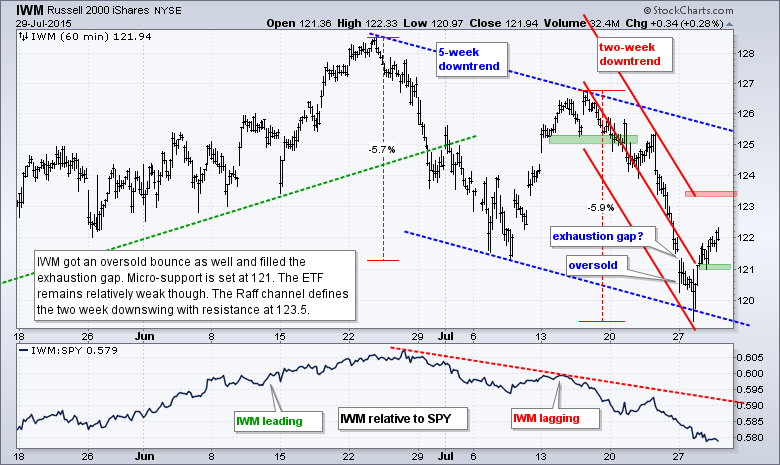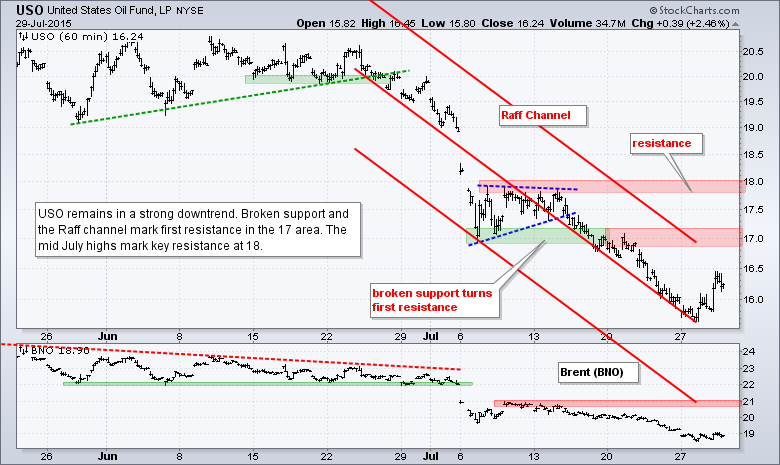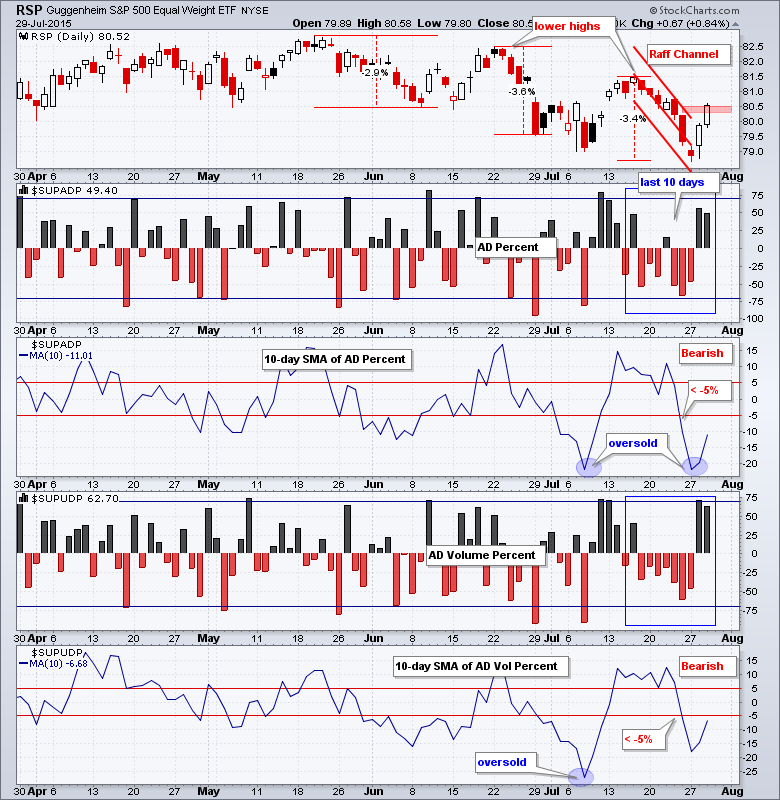Stocks moved higher on Wednesday, but the bounce was rather lopsided. Large-cap techs weighed on QQQ as the ETF gained .38%. The Nasdaq 100 Equal-Weight ETF (QQEW), in contrast, gained .93% on the day. The Russell 2000 iShares (IWM) gained just .28% and continues to lag. The S&P MidCap SPDR (MDY) led the major index ETFs with a 1.15% gain. All sectors were up with materials and energy leading the way. These sectors are getting oversold bounces as the worst hit sectors were the biggest gainers. The Equal-Weight Consumer Discretionary ETF (RCD) also showed some leadership with a 1+ percent gain and bounce off support. Once again, the Home Construction iShares (ITB) led the way with a 1.78% bounce. Nice to see ITB leading.
**This chart analysis is for educational purposes only, and should not
be construed as a recommendation to buy, sell or sell-short said securities**
Short-term Overview (Thursday, 30-July-2015):
- Short-term breadth is bearish.
- The five sector ETFs are split: two up, two down and one flat.
- SPY extended its oversold bounce with a resistance break.
- QQQ bounced off the 50% retracement line, but shows relative weakness.
- IWM got a weak oversold bounce and shows relative weakness.
- TLT is in a short-term uptrend and testing support.
- UUP bounced off support and remains in an uptrend overall.
- USO is in a short-term downtrend.
- GLD is in a short-term downtrend, but formed a small flag after an oversold bounce.
The Equal-Weight S&P 500 ETF (RSP) surged over the last two days to reverse the short-term downtrend. There are, however, two bigger problems. First, RSP remains in a downtrend overall with lower highs in late June and mid July. Second, SPY remains in a choppy trading range overall. It is still a choppy-flat environment overall.
Breadth is bearish overall because both 10-day SMAs remain in negative territory. AD Percent and AD Volume Percent were oversold on Monday and bounced the last two days. The bounce was impressive for AD Volume Percent because it exceeded +60% the last two days. AD Percent was not that strong as small-caps lagged.
The equal-weight sector ETFs are split: two in uptrends, two in downtrends and one flat. The Equal-Weight Consumer Discretionary ETF (RCD) got a strong bounce off support the last two days. The Equal-weight Finance ETF (RYF) and Equal-weight Healthcare ETF (RYH) remain in uptrends and are leaders overall. The Equal-weight Technology ETF (RYT) held its early June lows and bounced towards resistance. The Equal-weight Industrials ETF (RGI) got a big oversold bounce, but remains below resistance.
**************************************************************

**************************************************************

**************************************************************

**************************************************************

**************************************************************

**************************************************************

**************************************************************

***************************************************************
Key Reports and Events (all times Eastern):
Thu - Jul 30 - 08:30 - Initial Jobless Claims
Thu - Jul 30 - 08:30 - GDP
Thu - Jul 30 - 10:30 - Natural Gas Inventories
Fri - Jul 31 - 09:45 - Chicago PMI
This commentary is designed to stimulate thinking. This analysis is not a recommendation to buy, sell, hold or sell short any security (stock ETF or otherwise). We all need to think for ourselves when it comes to trading our own accounts. First, it is the only way to really learn. Second, we are the only ones responsible for our decisions. Think of these charts as food for further analysis. Before making a trade, it is important to have a plan. Plan the trade and trade the plan. Among other things, this includes setting a trigger level, a target area and a stop-loss level. It is also important to plan for three possible price movements: advance, decline or sideways. Have a plan for all three scenarios BEFORE making the trade. Consider possible holding times. And finally, look at overall market conditions and sector/industry performance.








